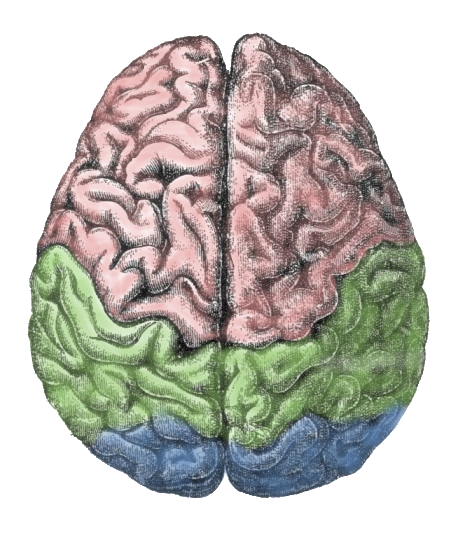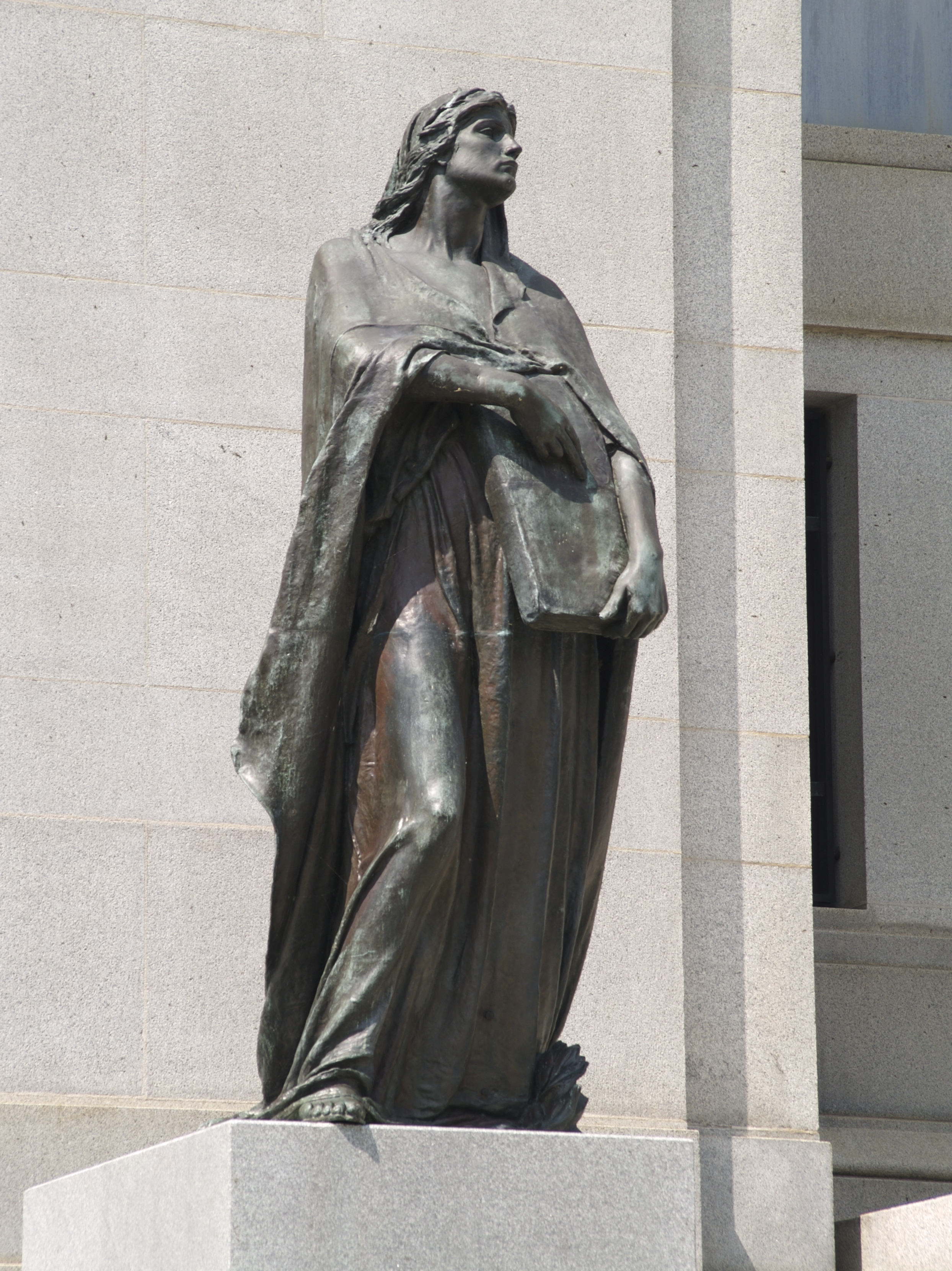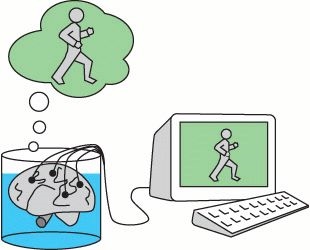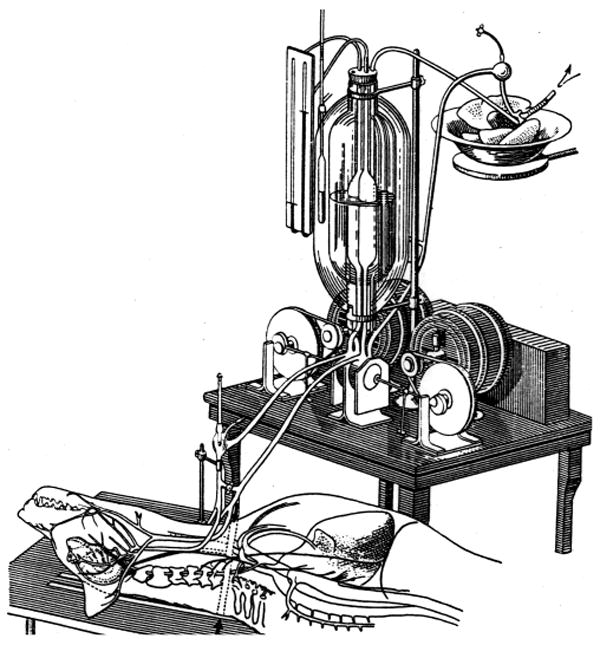|
Isolated Brain
An isolated brain is a brain kept alive in vitro, either by perfusion or by a blood substitute, often an oxygenated solution of various salts, or by submerging the brain in oxygenated artificial cerebrospinal fluid (CSF). It is the biological counterpart of brain in a vat. A related concept, attaching the brain or head to the circulatory system of another organism, is called a head transplant. An isolated brain, however, is more typically attached to an artificial perfusion device rather than a biological body. The brains of many different organisms have been kept alive in vitro for hours, or in some cases days. The central nervous system of invertebrate animals is often easily maintained as they need less oxygen and to a larger extent get their oxygen from CSF; for this reason their brains are more easily maintained without perfusion. Mammalian brains, on the other hand, have a much lesser degree of survival without perfusion and an artificial blood perfusate is usually used ... [...More Info...] [...Related Items...] OR: [Wikipedia] [Google] [Baidu] |
Cerebral Lobes
The lobes of the brain are the major identifiable zones of the cerebral cortex, and they comprise the surface of each hemisphere of the cerebrum. The two hemispheres are roughly symmetrical in structure, and are connected by the corpus callosum. They traditionally have been divided into four lobes, but are today considered as having six lobes each. The lobes are large areas that are anatomically distinguishable, and are also functionally distinct to some degree. Each lobe of the brain has numerous ridges, or gyri, and furrows, the sulci that constitute further subzones of the cortex. The expression "lobes of the brain" usually refers only to those of the cerebrum, not to the distinct areas of the cerebellum. Frontal lobe The frontal lobe is located at the front of each cerebral hemisphere and positioned in front of the parietal lobe and above and in front of the temporal lobe. It is separated from the parietal lobe by a space between tissues called the central sulcus, and from t ... [...More Info...] [...Related Items...] OR: [Wikipedia] [Google] [Baidu] |
Corneille Heymans
Corneille Jean François Heymans (28 March 1892 – 18 July 1968) was a Belgian physiologist. He studied at the Jesuit College of Saint Barbara and then at Ghent University, where he obtained a doctor's degree in 1920. Heymans won the Nobel Prize for Physiology or Medicine in 1938 for showing how blood pressure and the oxygen content of the blood are measured by the body and transmitted to the brain. Early life and education After graduation Heymans worked at the Collège de France (under Prof. E. Gley), the University of Lausanne (under Prof. M. Arthus), the University of Vienna (under Prof. H. H. Meyer), University College London (under Prof. E. H. Starling) and Case Western Reserve University School of Medicine (under Prof. C. F. Wiggers). In 1922 Heymans became lecturer in Pharmacodynamics at Ghent University, and in 1930 succeeded his father, Jean-François Heymans, as Professor of Pharmacology, as well as being appointed Head of the Department of Pharmacology, Pharmacody ... [...More Info...] [...Related Items...] OR: [Wikipedia] [Google] [Baidu] |
Mind
The mind is the set of faculties responsible for all mental phenomena. Often the term is also identified with the phenomena themselves. These faculties include thought, imagination, memory, will, and sensation. They are responsible for various mental phenomena, like perception, pain experience, belief, desire, intention, and emotion. Various overlapping classifications of mental phenomena have been proposed. Important distinctions group them according to whether they are ''sensory'', ''propositional'', ''intentional'', ''conscious'', or ''occurrent''. Minds were traditionally understood as substances but it is more common in the contemporary perspective to conceive them as properties or capacities possessed by humans and higher animals. Various competing definitions of the exact nature of the mind or mentality have been proposed. ''Epistemic definitions'' focus on the privileged epistemic access the subject has to these states. ''Consciousness-based approaches'' give primacy to ... [...More Info...] [...Related Items...] OR: [Wikipedia] [Google] [Baidu] |
Truth
Truth is the property of being in accord with fact or reality.Merriam-Webster's Online Dictionarytruth 2005 In everyday language, truth is typically ascribed to things that aim to represent reality or otherwise correspond to it, such as beliefs, propositions, and declarative sentences. Truth is usually held to be the opposite of falsehood. The concept of truth is discussed and debated in various contexts, including philosophy, art, theology, and science. Most human activities depend upon the concept, where its nature as a concept is assumed rather than being a subject of discussion; these include most of the sciences, law, journalism, and everyday life. Some philosophers view the concept of truth as basic, and unable to be explained in any terms that are more easily understood than the concept of truth itself. Most commonly, truth is viewed as the correspondence of language or thought to a mind-independent world. This is called the correspondence theory of truth. Various theo ... [...More Info...] [...Related Items...] OR: [Wikipedia] [Google] [Baidu] |
Reality
Reality is the sum or aggregate of all that is real or existent within a system, as opposed to that which is only imaginary. The term is also used to refer to the ontological status of things, indicating their existence. In physical terms, reality is the totality of a system, known and unknown. Philosophical questions about the nature of reality or existence or being are considered under the rubric of ontology, which is a major branch of metaphysics in the Western philosophical tradition. Ontological questions also feature in diverse branches of philosophy, including the philosophy of science, philosophy of religion, philosophy of mathematics, and philosophical logic. These include questions about whether only physical objects are real (i.e., physicalism), whether reality is fundamentally immaterial (e.g. idealism), whether hypothetical unobservable entities posited by scientific theories exist, whether a 'God' exists, whether numbers and other abstract objects exist, and ... [...More Info...] [...Related Items...] OR: [Wikipedia] [Google] [Baidu] |
Knowledge
Knowledge can be defined as awareness of facts or as practical skills, and may also refer to familiarity with objects or situations. Knowledge of facts, also called propositional knowledge, is often defined as true belief that is distinct from opinion or guesswork by virtue of justification. While there is wide agreement among philosophers that propositional knowledge is a form of true belief, many controversies in philosophy focus on justification: whether it is needed at all, how to understand it, and whether something else besides it is needed. These controversies intensified due to a series of thought experiments by Edmund Gettier and have provoked various alternative definitions. Some of them deny that justification is necessary and replace it, for example, with reliability or the manifestation of cognitive virtues. Others contend that justification is needed but formulate additional requirements, for example, that no defeaters of the belief are present or that the ... [...More Info...] [...Related Items...] OR: [Wikipedia] [Google] [Baidu] |
Thought Experiment
A thought experiment is a hypothetical situation in which a hypothesis, theory, or principle is laid out for the purpose of thinking through its consequences. History The ancient Greek ''deiknymi'' (), or thought experiment, "was the most ancient pattern of mathematical proof", and existed before Euclidean mathematics, where the emphasis was on the conceptual, rather than on the experimental part of a thought-experiment. Johann Witt-Hansen established that Hans Christian Ørsted was the first to use the German term ' (lit. thought experiment) circa 1812. Ørsted was also the first to use the equivalent term ' in 1820. By 1883 Ernst Mach used the term ' in a different way, to denote exclusively the conduct of a experiment that would be subsequently performed as a by his students. Physical and mental experimentation could then be contrasted: Mach asked his students to provide him with explanations whenever the results from their subsequent, real, physical experiment differed ... [...More Info...] [...Related Items...] OR: [Wikipedia] [Google] [Baidu] |
Philosophy
Philosophy (from , ) is the systematized study of general and fundamental questions, such as those about existence, reason, knowledge, values, mind, and language. Such questions are often posed as problems to be studied or resolved. Some sources claim the term was coined by Pythagoras ( BCE), although this theory is disputed by some. Philosophical methods include questioning, critical discussion, rational argument, and systematic presentation. in . Historically, ''philosophy'' encompassed all bodies of knowledge and a practitioner was known as a ''philosopher''."The English word "philosophy" is first attested to , meaning "knowledge, body of knowledge." "natural philosophy," which began as a discipline in ancient India and Ancient Greece, encompasses astronomy, medicine, and physics. For example, Newton's 1687 ''Mathematical Principles of Natural Philosophy'' later became classified as a book of physics. In the 19th century, the growth of modern research universiti ... [...More Info...] [...Related Items...] OR: [Wikipedia] [Google] [Baidu] |
In Vivo
Studies that are ''in vivo'' (Latin for "within the living"; often not italicized in English) are those in which the effects of various biological entities are tested on whole, living organisms or cells, usually animals, including humans, and plants, as opposed to a tissue extract or dead organism. This is not to be confused with experiments done ''in vitro'' ("within the glass"), i.e., in a laboratory environment using test tubes, Petri dishes, etc. Examples of investigations ''in vivo'' include: the pathogenesis of disease by comparing the effects of bacterial infection with the effects of purified bacterial toxins; the development of non-antibiotics, antiviral drugs, and new drugs generally; and new surgical procedures. Consequently, animal testing and clinical trials are major elements of ''in vivo'' research. ''In vivo'' testing is often employed over ''in vitro'' because it is better suited for observing the overall effects of an experiment on a living subject. In dr ... [...More Info...] [...Related Items...] OR: [Wikipedia] [Google] [Baidu] |
Rodolfo Llinás
Rodolfo Llinás Riascos (born 16 December 1934) is a Colombian-born American neuroscientist. He is currently the Thomas and Suzanne Murphy Professor of Neuroscience and Chairman Emeritus of the Department of Physiology & Neuroscience at the NYU School of Medicine. Llinás has published over 800 scientific articles. Early life Llinás was born in Bogotá, Colombia. He is the son of Jorge Enrique Llinás (a surgeon of Spanish descent, whose family arrived in Colombia at the end of the 19th century) and Bertha Riascos. He was motivated to study the brain by watching his grandfather Pablo Llinás Olarte working as a neuropsychiatrist. Llinás describes himself as a logical positivist. Education and early research Llinás went to the Gimnasio Moderno school in Bogotá and graduated as a medical doctor from the Pontifical Xavierian University in 1959. During his medical studies he had the opportunity to travel to Europe and there he met several researchers in Spain, France and fi ... [...More Info...] [...Related Items...] OR: [Wikipedia] [Google] [Baidu] |
Robert J
The name Robert is an ancient Germanic given name, from Proto-Germanic "fame" and "bright" (''Hrōþiberhtaz''). Compare Old Dutch ''Robrecht'' and Old High German ''Hrodebert'' (a compound of '' Hruod'' ( non, Hróðr) "fame, glory, honour, praise, renown" and ''berht'' "bright, light, shining"). It is the second most frequently used given name of ancient Germanic origin. It is also in use as a surname. Another commonly used form of the name is Rupert. After becoming widely used in Continental Europe it entered England in its Old French form ''Robert'', where an Old English cognate form (''Hrēodbēorht'', ''Hrodberht'', ''Hrēodbēorð'', ''Hrœdbœrð'', ''Hrœdberð'', ''Hrōðberχtŕ'') had existed before the Norman Conquest. The feminine version is Roberta. The Italian, Portuguese, and Spanish form is Roberto. Robert is also a common name in many Germanic languages, including English, German, Dutch, Norwegian, Swedish, Scots, Danish, and Icelandic. It can be use ... [...More Info...] [...Related Items...] OR: [Wikipedia] [Google] [Baidu] |
Experiments In The Revival Of Organisms
''Experiments in the Revival of Organisms'' (russian: О́пыты по оживле́нию органи́зма) is a 1940 motion picture, directed by David Yashin, that documents Soviet research into the resuscitation of clinically dead organisms. The operations in the film, as well as the design of the heart-lung machine demonstrated in it, the autojektor, were done by Sergei Brukhonenko, whose work in the film is said to have led to the first operations on heart valves. Synopsis The film depicts and discusses a series of medical experiments. The English version of the film begins with British scientist J. B. S. Haldane appearing and discussing how he has personally seen the procedures carried out in the film at an all-Russian physiological congress. The Russian version lacks this explanation. The experiments start with a heart of a canine, which is shown being isolated from a body; four tubes are then connected to the organ. Using an apparatus to supply it with blood, the ... [...More Info...] [...Related Items...] OR: [Wikipedia] [Google] [Baidu] |






